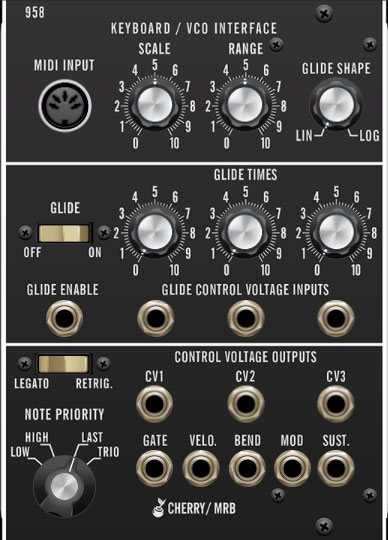The VM958 is a MIDI-to-CV converter that outputs monophonic control CV's. It also features a "trio" mode that can output three individual pitch CV's for "paraphonic" operation (three-note polyphony with common gate/envelope). It also includes independent glide time controls for each pitch CV.
MIDI Input Section
MIDI Input- This is where incoming MIDI signals are routed, either from Voltage's I/O Panel MIDI From Host jack, or from a module with a MIDI output.
Scale- Sets pitch tracking across the keyboard from 0/50% (24 keyboard half-steps = one octave) to 10/200% (6 keyboard half-steps = one octave). The default setting is 5/100%, i.e., standard 12 keyboard half-steps = one octave.
Range- Continuously sets pitch offset, up or down one octave, with 5 being nominal.
Glide Shape- Sets the voltage "curve" when using glide to linear, logarithmic or anywhere in between. When set to Linear, the voltage changes at the same rate for the duration of the note change; when set to Logarithmic, the voltage change gets slower as it approaches the destination CV.
Glide Section
Glide- Enables or disables glide for all three pitch CV's.
Glide Enable jack- Allows CV control of the Glide switch position. Voltages > 1V enable glide, voltages < 1V disable it. When a jack is inserted, the switch is disabled; when CV control is used, the switch automatically moves, Harry Potter-style for a visual indication of the glide state.
Glide Times- These individually set the speed of transition between pitch CVs for each of the three pitch CVs. If Note Priority is set to one of the mono modes (i.e. Low, High, or Last), only the left-most Glide Times knob is used. "Glide Times" also may or may not be a smash disco hit from the band Chic.
Glide Control Voltage Inputs- CV inputs for individually controlling the rate of glide for each Glide Time knob.
Control Voltage Outputs Section
Legato/Retrigger switch- If Legato is selected, the envelopes will only retrigger if no other notes are currently held. Legato mode is useful for emulating the sounds of some acoustic instruments - for example, the sound of plucking a note on a guitar, then sliding on the string to different notes without plucking again. If Retrig. is selected, the gate signal will restart every time a new key is pressed, thus retriggering any patched envelope generators. Retrigger mode generally feels more responsive to play and is useful for more aggressive passages.
Note Priority- Modular synths are most played monophonically (i.e. one note at a time), but VM958 also includes a three-note polyphonic "trio" mode. Below are the triggering characteristics for each Note Priority setting:
Low- If more than key is pressed, the lowest note will always sound. CV1, CV2, CV3 all output the same mono CV.
High- If more than key is pressed, the highest note will always sound. CV1, CV2, CV3 all output the same mono CV.
Last- This is the default voice mode. If more than one key is pressed, the most recently struck note will always take priority. CV1, CV2, CV3 all output the same mono CV.
Trio- Trio mode outputs up to three separate pitch CVs at the CV1, CV2, CV3 jacks, depending on how many notes are currently played. Note assignment is as follows:
CV1 = lowest note
CV2 = most recent middle note
CV3 = highest note
Gate- This is an "on/off" (0 or 5V) voltage typically used to engage envelope generators.
Velocity- Outputs a voltage upon keydown varying from 0-5V, dependent on how hard the key is struck. Useful for controlling filter cutoff amount and amplitude envelope intensity.
Bend- Outputs a variable negative or positive voltage as the pitch wheel is moved from its center position. range is one octave, up or down.
Mod- Outputs a variable constant voltage dependent on mod wheel position.
Sustain- Outputs a constant 5V when a controller's sustain pedal is down.
